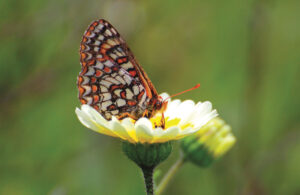Q: What’s the difference between bird songs and bird calls? [L.R., Santa Clara
A: Bird song, usually produced by the male, is an advertisement of territory and breeding availability, and, in most species, is limited to the breeding season. As in other animals, song serves to stimulate and synchronize sexual behavior (seduction), and to proclaim vigor and dominance. Some species—such as the northern mockingbird (we don’t call him polyglottus for nothing) and marsh wren—are inveterate blabber-mouths, babbling all year long. But most species conserve their songs for only those times that count. Some types of birds sing more than others; vultures are virtually mute, whereas vireos tend to sing continually during the breeding season. Some guy named DeKirline claims to have counted 22,197 repetitions by a red-eyed vireo of its song in a single day.
Bird calls tend to be unmusical, acoustically simpler, and less complex than the proclamatory songs, and they serve a variety of practical, non-sexual functions. Most have to do with coordinating behavior among other members of the species. Types of calls include location calls (to communicate whereabouts between pairs or among members of a flock), warning sounds, sharp notes to intimidate or drive away enemies (the braying of a scrub jay), and begging pleas.
We should also acknowledge that birds have many non-vocal modes of communication by sound: wing drumming of ruffed grouse, tail snapping
in hummingbirds and snipe, and bill hammering by woodpeckers are a few examples.
Through the trill of an orange-crowned warbler in a willow patch, the ventriloqual echo of a Swainson’s thrush from the forest depths, or the gurgle of a meadowlark perched on a coyote bush, we are hearing nature’s most articulate expression of the community in which the songster lives.
“A brown towhee has been flinging itself beak-first against a kitchen window since last summer. It used to similarly peck at my car’s side mirror but gave that up. Now it has started in on a living room window. I’m somewhat interested in the cause but more in a cure. I’m tempted to kill and eat the culprit but am not an experienced hunter.”—A.M., Berkeley
Narcissism may not be confined to Homo sapiens. But the myth that represents your towhee dilemma has more to do with Sisyphus than Narcissis. A recent study of bottlenosed dolphins found that individuals could recognize themselves in mirrors; the males, in particular, spent an inordinate amount of time admiring, or at least considering, their own image. Dolphins may be able to make the intellectual leap to abstraction and figure out that a reflection is not reality. Birds, however, have not had the evolutionary opportunities to develop such sophisticated reasoning skills. During the breeding season, song birds (including towhees) expend a tremendous amount of energy defining and defending their territories (see above). Your backyard bird probably considers his image as a territorial intruder and is exhausting himself in the Sisyphean task of challenging the bold interloper with the intent of driving that “other” bird out of his territory. As to a cure: If you can reduce the reflection with judicious placement of something outside the window (a lawn chair, a plant) you’ll probably do the towhee a favor and allow him to get back to his real business of eating seeds and raising his family.




